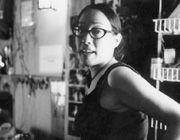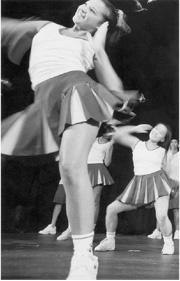Seattle Weekly: You went to NYU. Are you still in New York?
Karyn Kusama: I’ve been in New York for 14 years.
SW: Was it your intention to have a mostly Hispanic cast when you wrote the script?
KK: You know, it wasn’t. I didn’t really think about it. . . . I was more concerned with being truthful to the boxing community in New York. And in New York, it’s just a very mixed crowd. Certain gyms have a largely Latino contingent or a largely Polish contingent or a largely black contingent. The big, big gyms are mixed. But in the history of fighting, there’s so many great Latino fighters that I sort of wanted to honor that tradition. I also really wanted to make a movie that [was about] current New York, which is an overwhelmingly Latino city. . . . A friend of mine had a T-shirt the other day that said, “Welcome to America, now speak Spanish,” which I just thought was indicative of where New York is as a city. I also felt like Latino as a concept is one thing, but it represents such a diverse group of people. So within the gyms . . . you have your Mexicans, your Puerto Ricans, your Dominicans, your Colombians, your Cubans. You see camps and very distinct cultural identities that borrow and share from one another, and clearly reject cultural aspects of one another. And I just thought that was interesting because that seemed to be a very current expression of America at this point.
SW: Are you still boxing?
KK: I don’t really have the time right now. I would love to get back to it. I miss it, and I miss the people a lot, but I haven’t been able to recently.
SW: Is the gym where you boxed similar to the set?
KK: What was similar about it was that it was a sort of crummy, industrial space. There are really two different kinds of gyms. There’s the kind where the ring is in the center of the room: it’s a small room and everyone just sort of jumps ropes and works out around the ring. That to me wasn’t cinematically very interesting for my purposes. Seeing as how so much of the movie takes place in the gym, I wanted the gym to be a little bit more spacious, industrial, and warehousey. So in that regard the set of the gym is similar to say, a place like Gleason’s in Brooklyn, which is larger and has more than one ring. But Gleason’s is probably a much nicer gym. Even though the locker rooms are sort of crummy, they have showers. I wanted to keep this particular gym low-rent. Like a struggling little place that probably was popular 20 years ago, and is just now trying to make its mortgage payments.
SW: I really liked the scenes in her quote-unquote locker room.
KK: When I first started going to Gleason’s, there was a woman’s locker’s room but it was just like they put down an old piece of carpet that they must’ve found on the street. And I don’t actually think they had showers. And they just set up boxes for people to just throw their things in. So [for the movie] I was trying to imagine that kind of gym in an even rougher, even more sort of culturally isolated environment.
SW: Did you encounter people who believed that boxing was a way out of the ghetto?
KK: Oh, absolutely. I mean it’s a way of life. I think it’s a real philosophy. It’s incredible how hard it is to face the realities of the sport. You see those fighters who make decent livings if they’re journeymen, but at a terrible risk. There’s also the millionaires, like Oscar De La Hoya. It’s like any other profession where the promise of success is always there, and in athletics especially, you have to be a dreamer in a way to continue. I think it takes a particular kind of mind to first want to be a boxer and then to secondly succeed as a boxer. Of course what you need is physical skill and speed and grace and strength and power and all those things. But you really need a will to be the one-and-only standing in the ring. There’s something very singular about that kind of mind.
SW: Boxing is also a more democratic sport in that it gives a chance for smaller people to compete.
KK: It’s a wonderful thing because you see kids who come in and they’re like five feet tall. They’re 16-year-old boys and they weigh maybe 105 pounds or something. There is a division for those kids to be fighters. Once you watch those kids in the ring . . . you don’t think any more about how small they are or how oddly shaped they might be or how stocky. Boxing is one of those rare sports in my mind where you really are measured by very strict [standards]. I believe the divisions now are separated by six pounds. So, you’re really kind of within a very rarefied world—weight class to weight class. It’s a great opportunity for a lot of different kinds of kids to feel like they have a place. Because suddenly a place is made for them, as long as they can fight.
SW: I liked the motivational messages on pieces of cardboard taped to the walls of the gym. They lent a very authentic feel.
KK: That’s a very common thing in those gyms. People just tend to write an idea down and tack it up on the wall and you see all kinds of crazy sayings and quotes. Sometimes they get replaced by other things. It’s touching. There’s a sense of a homemade folklore that’s provided for the fighters. It’s very poignant.
SW: Obviously you put a lot of time and work into your script. Each line seemed to be very meaningful. Any time someone said something to Diana, she came right back with a killer line.
KK: There was a moment when we were cutting the movie where it seemed like she almost had a little too much of that snappy repartee. And it made me uncomfortable. I believe we actually tried to make her speechless a couple of times. Because when I set out to write the script, I didn’t anticipate the character’s voice to be as strong as it is. I thought of Diana initially as a character who was much more shut down and verbally muffled. And then when I was writing and really getting into draft after draft, I just felt it’s more interesting if she does know how to respond to the world. It’s just the world doesn’t know how to respond to her. But there was a moment when I thought she was able to come back with a snappy one-liner one too many times. I think I might have cut a couple of them, but unfortunately, they’re just so satisfying for an audience to see.
SW: Yeah, it was great!
KK: But I did work on the script for a long time. It went through a lot of changes.
SW: How do you go from putting so much work and thought into a script like that, and then handing it over to an unknown actress?
KK: Well, it was hard. It was really difficult. We worked a long time. What was really good was that [Michelle Rodriguez] was open about the fact that she needed help. Because she’d never acted before, she was able to say, “Look, I just don’t know what I’m doing.” And it was obvious, because when she first auditioned it was sort of like, wow, she’s got tremendous raw talent! It was pretty apparent to me that I would just need to work with her on the script and ease her into certain scenes that were especially difficult—just to get a sense of how she was interpreting the material. And luckily, she had a logic behind most of the lines that was exactly what I was looking for. There were a couple of times when she felt like some dialogue was inappropriate or wouldn’t be truthful to the character, and we talked about when I agreed with her and when I didn’t.
SW: Did Michelle box before?
KK: No, she went through a four-and-a-half month training period. And to this day, she tells me, “I gained weight for you!” But I think she looks great in the movie.
For more on Girlfight, read Knock out.







